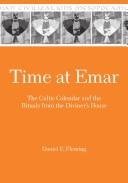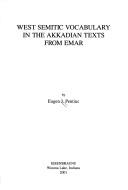| Listing 1 - 3 of 3 |
Sort by
|
Book
ISBN: 9781575069319 1575069318 9004370048 9789004370043 Year: 2019 Volume: 59 Publisher: [Leiden]
Abstract | Keywords | Export | Availability | Bookmark
 Loading...
Loading...Choose an application
- Reference Manager
- EndNote
- RefWorks (Direct export to RefWorks)
The city of Emar, modern Tell Meskene in Syria, is one of the most important sites of the western ancient Near East during the Late Bronze Age that have yielded cuneiform tablets. The discovery of more than one thousand tablets and tablet fragments assures Emar's position, along with Bogazkoy-Hattusa and Ras-Shamra-Ugarit, as a major scribal center. Ephemeral documents such as wills or sale contracts, texts about rituals and cultic festivals, school texts and student exercises, and inscribed seals and their impressions enable reconstruction of the Emar scribal school institution and provide materials for investigation into the lives of more than fifty scribes whose works were found in the city. The aim of this book is to place Emar's scribal school institution within its social and historical context, to observe the participation of its teachers and students in the study of the school curriculum, to investigate the role of the scribes in the daily life of the city (in particular within the administration), and to evaluate the school's and its members' position within the network of similar institutions throughout the ancient Near East.
Scribes --- Scholars --- Cuneiform writing --- Bronze age --- History. --- Emar (Extinct city) --- Intellectual life. --- Persons --- Learning and scholarship --- Copyists --- Alphabet --- Civilization, Assyro-Babylonian --- Inscriptions --- Paleography --- Writing --- Achaemenian inscriptions --- Cuneiform inscriptions --- Civilization --- History --- Emar (Ancient city) --- Maskanah Site (Syria) --- Meskéné Site (Syria) --- Syria --- Antiquities --- Bronze age. --- Cuneiform writing. --- Scholars. --- Scribes. --- Cultural life --- Emar --- Middle East --- Culture

ISBN: 1575065223 9781575065229 1575060442 9781575060446 1575060442 9781575060446 Year: 2021 Publisher: University Park, PA
Abstract | Keywords | Export | Availability | Bookmark
 Loading...
Loading...Choose an application
- Reference Manager
- EndNote
- RefWorks (Direct export to RefWorks)
The recent large-scale watershed projects in northern Syria, where the ancient city of Emar was located, have brought this area to light, thanks to salvage operation excavations before the area was submerged. Excavations at Meskeneh-Qadimeh on the great bend of the Euphrates River revealed this large town, which had been built in the late 14th century and then destroyed violently at the beginning of the 12th, at the end of the Bronze Age. In the town of Emar, ritual tablets were discovered in a temple that are demonstrated to have been recorded by the supervisor of the local cult, who was called the “diviner.” This religious leader also operated a significant writing center, which focused on both administering local ritual and fostering competence in Mesopotamian lore. An archaic local calendar can be distinguished from other calendars in use at Emar, both foreign and local. A second, overlapping calendar emanated from the palace and represented a rising political force in some tension with rooted local institutions. The archaic local calendar can be partially reconstructed from one ritual text that outlines the rites performed during a period of six months.The main public rite of Emar’s religious calendar was the zukru festival. This event was celebrated in a simplified annual ritual and in a more elaborate version of the ritual for seven days during every seventh year, probably serving as a pledge of loyalty to the chief god, Dagan. The Emar ritual calendar was native, in spite of various levels of outside influence, and thus offers important evidence for ancient Syrian culture. These texts are thus important for ancient Near Eastern cultic and ritual studies. Fleming’s comprehensive study lays the basic groundwork for all future study of the ritual and makes a major contribution to the study of ancient Syria.
Rites and ceremonies --- Religious calendars --- Calendar, Religious --- Calendars, Religious --- Church calendar --- Ritual calendars --- Calendar --- Ceremonies --- Cult --- Cultus --- Ecclesiastical rites and ceremonies --- Religious ceremonies --- Religious rites --- Rites of passage --- Traditions --- Ritualism --- Manners and customs --- Mysteries, Religious --- Ritual --- Emar (Extinct city) --- Emar (Ancient city) --- Maskanah Site (Syria) --- Meskéné Site (Syria) --- Syria --- Religion. --- Antiquities --- HISTORY / Ancient / General. --- Emar (Extinct city).

ISBN: 1575069105 9004369872 9789004369870 9781575069104 Year: 2018 Publisher: [Place of publication not identified]
Abstract | Keywords | Export | Availability | Bookmark
 Loading...
Loading...Choose an application
- Reference Manager
- EndNote
- RefWorks (Direct export to RefWorks)
Part 1 of this study is a glossary with comparative analysis of non-normative Akkadian forms, Hittite and Hurrian words, West Semitic lexemes, and words of uncertain origin, with special attention given to the West Semitic forms. Part 2 consists of grammatical observations pertaining to the West Semitic forms, under the headings orthography, phonology, and morphology.
Semitic languages, West --- Akkadian language --- Langues sémitiques occidentales --- Akkadien (Langue) --- Glossaries, vocabularies, etc. --- Grammar --- Texts --- Glossaires, vocabulaires, etc --- Grammaire --- Textes --- Emar (Extinct city) --- Emar (Ville ancienne) --- Foreign words and phrases --- Semitic, West. --- Grammar. --- Emar (Extinct city). --- Langues sémitiques occidentales --- Semitic languages, West. --- West Semitic languages --- Semitic languages --- Syria --- Emar --- Middle East --- Emar (Ancient city) --- Maskanah Site (Syria) --- Meskéné Site (Syria) --- Antiquities --- Langues sémitiques occidentales septentrionales --- Akkadien (langue) --- Emar (ville ancienne) --- Glossaires, vocabulaires, etc. --- Emprunts sémitiques
| Listing 1 - 3 of 3 |
Sort by
|

 Search
Search Feedback
Feedback About UniCat
About UniCat  Help
Help News
News